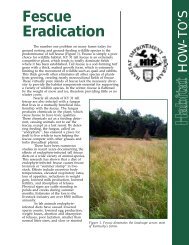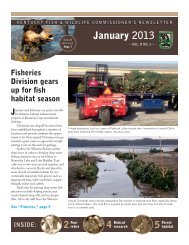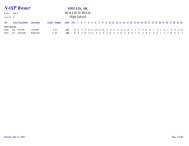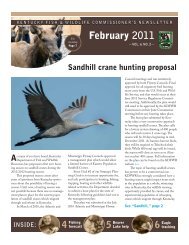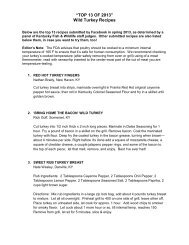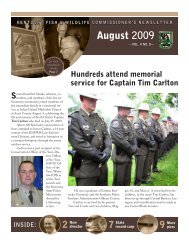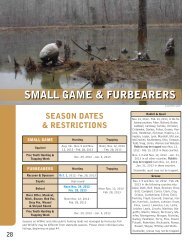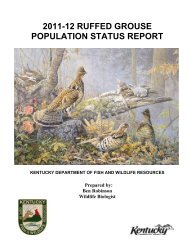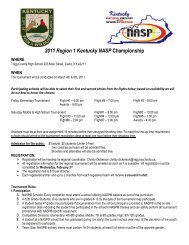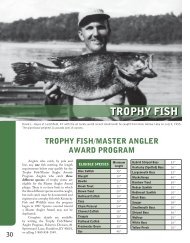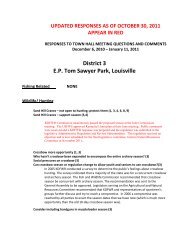District 2 Merle Travis Music Center, Powderly - Kentucky ...
District 2 Merle Travis Music Center, Powderly - Kentucky ...
District 2 Merle Travis Music Center, Powderly - Kentucky ...
Create successful ePaper yourself
Turn your PDF publications into a flip-book with our unique Google optimized e-Paper software.
Fishing Related<br />
UPDATED RESPONSES AS OF OCTOBER 30, 2011<br />
APPEAR IN RED<br />
RESPONSES TO TOWN HALL MEETING QUESTIONS AND COMMENTS<br />
December 6, 2010 – January 11, 2011<br />
<strong>District</strong> 2<br />
<strong>Merle</strong> <strong>Travis</strong> <strong>Music</strong> <strong>Center</strong>, <strong>Powderly</strong><br />
Problem of Asian Carp in lakes & rivers (1, 2)<br />
The Fisheries director and KDFWR Commissioner continue to pursue funding assistance by<br />
attending meetings with federal agencies and having discussions with state and federal legislators.<br />
The market industry is looking very promising, and several companies are gearing up to begin<br />
harvesting Asian carp in <strong>Kentucky</strong>. Two companies are constructing processing facilities in<br />
neighboring states, and both plan to utilize offloading facilities in <strong>Kentucky</strong>. Another company is<br />
located in Livingston County, KY and has already been buying limited quantities of Asian carp;<br />
they also plan to increase their facilities' capacities in <strong>Kentucky</strong>. Additionally, there are several<br />
companies still interested in expanding into <strong>Kentucky</strong>. These mega-processing facilities will<br />
export millions of pounds of the Asian carp to places like China and the Middle East. During the<br />
last several weeks, this department has also learned that there is a large domestic market for fish<br />
meal made from Asian carp. Finally,we are in the process of gearing up for a large Asian carp<br />
research project that will examine Asian carp abundance and their effect on natve fish species.<br />
The department is also addressing the problem of live bait fishermen accidentally netting and<br />
unintentionally spreading the carps by using them as bait in reservoirs and other rivers and<br />
streams. We have distributed posters, brochures and informative cards concerning identification<br />
problems between young Asian carp and shad. Hopefully, this wil curtail the spread of the Asian<br />
carp to new waters. This department is also using signage, the media, and the internet to inform<br />
sportsmen who harvest Asian carp that it is unlawful to throw fish indiscriminantly on shorelines,<br />
public access areas, parking areas, or boat ramps; it is considered littering. All unused fish should<br />
be properly disposed of in containers, landfills, or by giving the fish to those who would eat the<br />
fish or use them for fertilizer. When only a few fish are harvested, they can also be humanely<br />
destroyed and swim bladders punctured prior to releasing the fish in waters where they will<br />
decompose naturally without becoming a health issue.<br />
Wildlife / Hunting<br />
Tick Management (2)<br />
The <strong>Center</strong> for Disease Control (CDC) issued an integrated guide for homeowners, pest<br />
control operators, and public health officials for the prevention of tick-associated<br />
disease. A copy of the Tick Management Handbook can be found at the link below:<br />
o www.cdc.gov/ncidod/dvbid/lyme/resources/handbook.pdf<br />
Deer population has decreased (1, 2, 3, 4, 7, 8, 9)
Current statewide deer population trends are nearly stable to slightly decreasing. Over<br />
the past few years deer zones in many counties have been made more restrictive to try<br />
to boost the deer population. KDFWR deer biologists look at each county’s deer<br />
population trend every year. Based on that population trend a county’s zone can be<br />
changed to better manage the deer population in the county. A county’s deer zone is<br />
determined by a combination of many things. Along with the population model, deer<br />
vehicle collision numbers, crop damage complaints, and hunter satisfaction are all taken<br />
into account when determining what a county’s zone should be.<br />
Need zone change in Ohio Co. (2)<br />
The zone was changed in Ohio County from a zone 2 to a zone 3 for the 2010 hunting<br />
season. When a zone is changed, KDFWR needs at least 3 years to assess the effect of<br />
the zone change. The county will be re-examined after 3 years and KDFWR will<br />
reevaluate the zone and determine what needs to be done based on the<br />
population/harvest trends.<br />
Earn A Buck (EAB) Program for quality deer management (2)<br />
The current level of doe harvest should continue to stabilize the herd without adding<br />
further restrictions beyond the 1-buck limit. The EAB concept would be impossible to<br />
enforce with our system and level of manpower without widespread hunter support and<br />
voluntary compliance. Most hunters do not support such a restriction.<br />
Change waterfowl season (2, 4, 6)<br />
2-5 days early waterfowl season in October, early November (2)<br />
Changes in season structure cannot be implemented solely by the state. States must meet specific<br />
criteria set forth by the US Fish and Wildlife Service USFWS). Changes must fall into one of four<br />
categories, must have a contiguous boundary and may only occur during specified (open window)<br />
interval.<br />
Given USFWS criteria if <strong>Kentucky</strong> changed its season structure to three segments we would also<br />
be required to change the youth waterfowl season structure because it would not fit into the federal<br />
season structures. This change would affect hunters in the Eastern Duck Zone accustomed to<br />
taking youth hunting during the first weekend of November. Based upon the uncertainty<br />
regarding hunter preference for a particular season format the Wildlife Division recommends the<br />
Commission postpone making a decision on this issue until the 2012 -13 regulatory period and<br />
implement the same season format as used during the 2010 – 11 period. The Service’s window<br />
for making season format changes is scheduled to remain open for 2012 – 13 regulations period.<br />
This additional time will allow the Wildlife Division to survey waterfowl hunters in effort to try<br />
and determine their season format preference.<br />
There is interest among some hunters to modify the current duck season framework to include a<br />
third segment to be held in late October or early November. While we have received<br />
communications asking us to look at this possibility, we have also heard from hunters who do not<br />
support a change.<br />
Late Muzzleloader season – change to every weekend of December only (2)<br />
There is simply no time or place to move or expand the muzzleloader season. Deer gun<br />
hunters have to balance hunting time in the field with small game hunters, archery<br />
hunters, waterfowl hunters, predator hunters, and elk hunters. When season lengths<br />
and dates are changed for one user group it affects another hunting user group.
Although it might make sense to one user group to make a date change, such changes<br />
are negatively viewed by other user groups.<br />
Change youth season (2, 4, 7, 9)<br />
Youth season for deer – September doe hunt. (9)<br />
There are 4 days of youth deer season, 2 days in October (2 nd weekend) and 2 days in<br />
December (weekend after Christmas). KDFWR encourages adults to take youth during<br />
any season – youth are by no means restricted to only hunting during the youth<br />
seasons! No change to youth seasons is currently recommended. Current youth seasons are the<br />
best compromise at this point.<br />
Concerns on decline of small game & seasons (rabbits, quail, grouse) (1, 2, 3, 4, 5, 7, 8 ,9)<br />
The Department shares the concern for decline of small game. The seasons continue to<br />
be a popular debate with overlap of deer seasons and creating a single season that ends<br />
sometime in February. KDFWR has been one of the national leaders in restoration for<br />
bobwhite (mgt will also benefit rabbits). We also continue to move towards a more<br />
active forest management program on WMAs and through private lands efforts that will<br />
benefit ruffed grouse.<br />
KDFWR is working to create a cooperative program for private land owners to support small<br />
game management practices, which will include evaluating cost-benefit of existing tactics and<br />
developing critical measures of success.<br />
Removal of beavers from Pond River (2)<br />
The Department recommends contacting your local Private Lands Wildlife Biologist to<br />
assist in a resolution; contact information for biologists can be found by calling 1-800-<br />
858-1549. Year-round assistance can also be obtained from a Nuisance Wildlife Control<br />
Operator by searching our website at http://fw.ky.gov/app1/NuisanceLookup.aspx.<br />
Lastly, the Department offers a free program to provide fur trapper contact information<br />
to landowners suffering livestock, fish, crop losses due to furbearers; contact<br />
information can be found by visiting our website at<br />
http://fw.ky.gov/app/trapperlandowner.aspx.<br />
Against buying hogs to hunt (2)<br />
The increasing spread of wild pigs throughout <strong>Kentucky</strong> is a serious concern for the Department.<br />
Collectively, the KDFWR is using intensive removal efforts and public education to halt the<br />
release and spread of pigs in the Commonwealth. The KDFWR and the <strong>Kentucky</strong> Department of<br />
Agriculture have laws making it illegal to possess wild pigs. Technical guidance for control and<br />
removal efforts can be obtained from the KDFWR Info <strong>Center</strong>. In addition, the KDFWR website<br />
will add a section that details the destructive capabilities of wild pigs and the necessary removal<br />
efforts for control.<br />
Higginson Henry – picnic tables that were donated by private individuals – how can we get<br />
them put back without red tape? (2)<br />
Picnic tables will be placed if requested via event permit with 30 days notice. We will be meeting<br />
with local area user groups soon to discuss other possible alternative sites for picnic tables.<br />
Higginson & Henry – issues with Mgr not mowing area to be used when permit is issued for an<br />
event – it is a safety issue.<br />
Upcoming meeting with user groups will clarify concerns. At least 30 days notice on event<br />
permits and clear communication in the request, as well as with the area manager, are critical..
Higginson & Henry – organize cleanup efforts – every time there is lots of red tape – why<br />
when we are volunteering?<br />
A large cleanup effort was just completed on H&H going through the event permit process. This<br />
process is in place to minimize conflicts and insure the work being requested is within the<br />
parameters of the desired intent of the area.<br />
Higginson & Henry – Horseback riding. Loss of 7 miles of trails since 1999. Any plans to clean<br />
& restore trails?<br />
The KDFWR manages WMA’s with the primary focus of improving and conserving wildlife<br />
habitat and the associated hunting & fishing resources. Trail locations are chosen to lessen<br />
potential impacts to this primary focus. The original 8-miles of trails on the area were designated<br />
as “hiking” trails; in 2000, given the increase in unauthorized trail creation, 10-miles of trails were<br />
designated for horseback riding. The perceived loss of trails can be attributed to the closure of the<br />
unauthorized trails. Trail maintenance is conducted when limited staff time is available and<br />
doesn’t conflict with primary focus activities.<br />
Fence in property to reserve area for handicap hunters (2)<br />
KDFWR is committed to the concept of fair chase hunting and applies these<br />
principles to all of our public hunting opportunities. Providing mobility-impaired<br />
hunting and fishing opportunities is important, and we continue to increase<br />
these opportunities on public land through hunting blinds, fishing jetties and pier<br />
construction, and WMA mobility-impaired designations.<br />
Future of Peabody (2)<br />
In 2008 Peabody WMA embarked on a long-term project designed to benefit<br />
small game populations and grassland songbirds while providing better habitat<br />
and forage for deer and turkey. Waterfowl continue to be a priority and new<br />
wetland opportunities are being evaluated. The Fisheries Division has recently<br />
begun focusing on WMA lake habitat by placing fish attractors, improving boat<br />
ramps and increasing bank access on the area.<br />
Concerns about Peabody when Armstrong starts mining (2)<br />
Armstrong Coal controls a significant portion of the mineral rights under the<br />
WMA and may open multiple mines on the area in the near future. KDFWR will<br />
work closely with Armstrong Coal and the Division of Surface Mining to reduce<br />
the impact to public hunting and fishing access on the area, but mining<br />
regulations require limited access to permitted mine areas and therefore some<br />
areas may need to be closed during active mining and reclamation operations.<br />
Habitat improvement on WMA’s – why are they not apparent – especially on Peabody (2)<br />
Not all management activities are evident to the general public since they are not always an<br />
annual activitynor do they have the appearance of a food plot. We plan to do a better job of<br />
educating area users and surrounding landowners with a campaign for educating the public on<br />
habitat management practices on WMAs which may include such things as signage, web videos,<br />
area field days, etc.<br />
Change youth season (2, 4, 7, 9)<br />
In October – November when temperatures are milder (2)<br />
There is simply no time or place to move or expand the youth season. Deer gun hunters<br />
have to balance hunting time in the field with small game hunters, archery hunters,
waterfowl hunters, predator hunters, and elk hunters. When season lengths and dates<br />
are changed for one user group it affects another hunting user group. Although it might<br />
make sense to one user group to make a date change, such changes are negatively<br />
viewed by other user groups.<br />
Opposed to elk being reintroduced into KY (2)<br />
A public opinion survey conducted by Responsive Management in 2011 found 78% of<br />
Kentuckians support having wild elk in KY; only 8% oppose. A summary of the survey report will<br />
be posted online by Dec. 31, 2011.<br />
Preference points for elk (2, 4, 6, 7, 8)<br />
The elk quota hunt does not use preference points the way that the deer quota hunts in<br />
Ky (and many western states elk hunts) do. This is due to the extreme difference in the<br />
number of applicants versus the number of permits available. As it stands now, every<br />
person has the exact same change to be drawn for a tag as everyone else (except that<br />
KDFWR only awards up to 10% of the tags to non-residents) Even with preference<br />
points, a person likely would never be “guaranteed” to get drawn eventually, the way<br />
they currently are for deer quota hunts.<br />
Law Enforcement Related<br />
Other<br />
Use the “spirit” of the law versus the “letter” of the law to promote a positive quality<br />
experience (2)<br />
The “letter” of the law and the “spirit” of the law should directly reflect each other. If<br />
you feel there is an issue with a particular law then you should contact your legislative<br />
body or commission member to rectify what you believe is an issue that needs to be<br />
addressed.<br />
Hunting on neighbor’s property is a issue (1, 2, 5)<br />
If you have an issue with hunting without permission or believe that there is illegal<br />
hunting occurring on a neighboring property we encourage you to report that activity to<br />
the 1-800-25ALERT hotline for an officer to contact you.<br />
Horses on WMA’s – Horseback riding on WMA’s (2, 3, 5)<br />
Managing recreational use on public land is a balancing act. The intended purposes of WMAs are<br />
to provide for wildlife conservation, habitat management, hunting, and other wildlife-related<br />
recreation. Other recreational opportunities are provided when economically and logistically<br />
possible, as long as they do not interfere with the primary intended purpose of the property.<br />
Currently, we have approximately 200 miles of designated horse trails on 14 WMAs and one<br />
Outdoor Recreation Area in the state. Horseback riding is also allowed on over 500 miles of<br />
unpaved WMA roadways. Though not a WMA, the Department has recently acquired and<br />
provided new trail riding opportunities at Otter Creek Outdoor Recreation Area in Meade County.<br />
Loss of opportunity for riders (2)<br />
Wrangler camps lost trails to hunting (2)
The Department has actually expanded horseback riding opportunity in the last 10 years. For<br />
example, a cooperative agreement was recently reached with Floyd County for over 20 miles of<br />
additional horseback riding opportunity on Dewey Lake WMA. Though not a WMA, the<br />
Department has also provided new trail riding opportunity at Otter Creek Outdoor Recreation Area<br />
in Meade County. Furthermore, each time the Department acquires additional WMAs, there is<br />
usually increased opportunity in the form of unpaved roadways that may exist on the properties.<br />
Riders glad to pay user fee of $15 to be allowed to use hunting trails for riding (2)<br />
Regardless of any additional user pay permit systems, WMAs have to be managed for<br />
their primary intended purpose. If not, loss of federal funds is a possibility. Alternative<br />
recreational uses are already allowed on WMAs when they are compatible,<br />
economically feasible, logistically possible, and environmentally sound.<br />
Regardless of any additional user pay permit systems, WMAs have to be managed for their<br />
primary intended purpose. If not, loss of federal funds is a possibility. Alternative recreational uses<br />
are already allowed on WMAs when they are compatible, economically feasible, logistically<br />
possible, and environmentally sound. Horseback riding is just one of many other secondary uses<br />
allowed on WMAs if compatible with the management of a particular WMA. The Department has<br />
no immediate plans to charge for horseback riding on WMAs.Howver, the Department has<br />
adopted a user pay system for horseback riding on Otter Creek Outdoor Recreation Area, but this<br />
is a unique situation, as this area is not a WMA.<br />
Reduce the conflict & become partners (2)<br />
We have several partnerships with local conservation organizations, sportsman's clubs, school, 4-<br />
H and Boy Scout groups, etc. across the state and value the work provided by all these groups.<br />
Horseback riders are sportsmen; most have hunting & fishing license (2)<br />
Some horseback riders are sportsmen, some are not. Some hunters are anglers, while<br />
others are not. Our primary constituents are those who purchase hunting and fishing<br />
licenses. Our primary mission is for fish and wildlife management and wildlife-related<br />
recreational opportunity.<br />
Publicizing of Public Meetings is poor (2)<br />
We are committed to doing a better job getting the word out next time. Keep in mind<br />
public meetings, although a very important informational tool is just one snapshot we<br />
take when connecting to the public. We just completed an on line deer survey with<br />
over 10,000 respondents.<br />
Raise the cost of out-of-state license fees<br />
KDFWR plans to initiate a price-elasticity study during calendar year 2011. At this time,<br />
the department will compare our resident and non-resident license and permit fees
with other states, and particular with <strong>Kentucky</strong>’s Border States to ascertain whether or<br />
not we are competitive in both pricing and opportunities provided. Based on this study,<br />
the department expects to amend our current fee structure.<br />
Lifetime licenses<br />
The department last reviewed the concept of “Lifetime Licenses” in 2009. At that time,<br />
we surveyed 32 states, of which 22 of these currently or previously offered lifetime<br />
licenses. At least one-half of these states also received an annual general fund<br />
appropriation, which KDFWR does not. States that had discontinued their sale of<br />
lifetime licenses had done so due to 1) loss of revenue due to large sales to youth and<br />
those moving out of state; and/or 2) too many maintenance requirements for the<br />
lifetime holders. That said, the number one reason (more than 60%) for state fish and<br />
wildlife agencies to offer lifetime licenses was “customer request and satisfaction.”<br />
Other reasons included “to provide money up front for the agency”, “to minimize<br />
churn”, and “to promote hunting and fishing opportunities.”<br />
Because of the potential benefits of lifetime license, KDFWR plans to look more formally<br />
into the possibility of offering lifetime licenses when we conduct the price-elasticity<br />
study planned for 2011 (as described above). Additionally, for KDFWR to issue Lifetime<br />
Licenses, a statutory change to KRS 150. 175 would be required.<br />
Small interest groups and legislators are influencing F & W issues (2,8)<br />
KDFWR recognizes that a variety of groups and state legislators have an interest in fish and<br />
wildlife related issues. The department strives to communicate and educate our sportsmen and<br />
women as well as other constituents, partner organizations, and both state and federal legislators<br />
on issues that are important to successful wildlife management and supportive of our mission.<br />
New River Bridge on HWY 62 – boat ramp to access Pond River (2)<br />
The KDFWR has scheduled a site visit with local officials to investigate the feasibility of<br />
constructing a ramp at this location.<br />
Would like to have a place in the county for shooting sports (4-H, explore bowhunting, youth<br />
trap shoot, skeet & rifle) (2)<br />
The KDFWR currently has two public rifle ranges in the 2 nd <strong>District</strong>. One range is on<br />
Higginson Henry WMA in Union County and one on Peabody WMA in Ohio County.<br />
Boat ramp/access/parking lots (2, 5, 6, 7)<br />
The KDFWR needs input from the public on possible locations for new boat ramps and<br />
we would like to know about any maintenance issues at our existing access sites. If the<br />
site you are interested in was not mentioned in the Town Hall Meeting please call us.<br />
Boat ramp at Town Creek, excavators were blocking parking area.<br />
This boat ramp has been completed and is open to the public for use.
Frankfort has lost touch with communities (1,2)<br />
KDFWR’s strategic plan specifically identifies that one of the agency’s goals is: To foster<br />
a more informed and involved public. The entire plan is available to the public at<br />
fw.ky.gov, and by direct request. Agency personnel routinely attend monthly League of<br />
<strong>Kentucky</strong> Sportsmen Federation meetings, conduct several deer management meetings,<br />
hold Town Hall meetings statewide, and have quarterly Committee and Commission<br />
meetings. In the last year, KDFWR put a social networking plan in place that provides “to<br />
the minute” actions and information. The Department’s website has been improved<br />
and expanded, and provides an opportunity for the public to directly have questions and<br />
concerns addressed by e-mail response at any time. We will continue to be responsive<br />
to community needs, and afford sportsmen and women a chance to voice their opinion,<br />
questions, and concerns. Communication is best maintained on a two-way street and<br />
both the agency and constituent are equally responsible to explore all avenues possible.<br />
Many are available, free and are being used daily.<br />
Concerns about loss of eye-to-eye contact with folks and ensuring folks have a good<br />
experience (2)<br />
KDFWR goes to great lengths to be accessible to the public and our license/permit holders.<br />
We have over 470 employees that deal with the public daily. Our strategic goals specifically<br />
state we will be responsive to our constituents needs, address the resource needs, and<br />
provide added public opportunity. We do that today, and will continue to do that in the<br />
future.<br />
Need more places to hunt (1, 2, 3, 5, 6, 7, 8, 9)<br />
Buy more property for public access (1, 2, 5)<br />
Over the last four years and with the commitment of $1 million per year, KDFWR has increased,<br />
by close to 10 thousand acres, the amount of land owned by the department and now available for<br />
public access. Within these newly owned areas, the department has now made available nearly<br />
4,000 acres, specifically located in and around the state’s most populous area (i.e., the Golden<br />
Triangle of Louisville, Lexington and Northern <strong>Kentucky</strong>). Further, the department averages each<br />
year approximately 150 thousand acres in private landowner access agreements, which makes<br />
even more land available to the public. Aside from new hunting opportunities, KDFWR has also<br />
developed 13 new bank access sites and more than 30 boating access sites in the last four years;<br />
whereas the department now offers 34 new lake fishing opportunities in and around <strong>Kentucky</strong>’s<br />
urban areas through our Fishing in Neighborhoods program.



